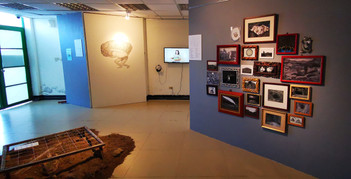








須彌:挖洞即造山
SUMERU:CAVING IS OROGENY
高俊宏
Jun-Honn Kao
「須彌」在佛教、耆那教、印度教的宇宙論中代表最高的神山,是世界的中心。須彌外的人類居所加上諸天所居的天界,共同構成有情居住的器世間。承載大航海時代的沉船、原住民種族屠殺、定居殖民以及白色恐怖歷史等多重歷史的綠島,也恰如一個有情居住的器世間。《須彌》以綠島傳奇的黃金挖掘事件、鄉野傳說以及政治受難前輩曹開的數學詩裡關於「〇與洞」的詩句出發,以古沈船結構圖、挖洞工程圖、田野訪談、挖洞的再現演出為形式,試圖探討人的情念、生命的徒勞與創造的奧秘。以「挖洞即造山」為概念,推演挖洞亦即堆砌須彌之山,藉此隱喻歷史悲劇的救贖與昇華。高俊宏宛如曹開詩中的「零騎士」,以「挖洞」行為展現生命的空無與無限。一如曹開詩文所言:「零為圓之洞孔,但圓有限,零卻無窮。」「零是無邊無際的總和/它是宇宙之母/從它的胎盆/萬物產生。」
According to the cosmology of Buddhism, Jainism, and Hinduism, Sumeru is the highest sacred mountain and the center of the world. The universe of beings is made up with residence of immortals in the mountain and dwellings of human surrounding it. Similar to Sumeru, the Green Island, having witnessed wrecks from the Great Nautical Age, aboriginal genocide, settler colonialism and the White Terror, is also a place of beings. Inspired by Kai Tsao's mathematical poems about "0 and Hole," the artist recounts the gold mining legend and folktales of the Green Island through ancient shipwreck structure drawings, tunneling construction drawings, field interview records and reproduction of caving activities in "Sumeru." He attempts to explore human affections, futility of life and mystery of creation based on the concept of "caving is orogeny." Digging is a way of building Sumeru, a symbol of the redemption and sublimation of historical tragedies. The artist interprets the emptiness and infinity of life through the act of caving as if he takes the role of the "Zero Knight" in Tsao's poem, which goes "Zero is a hole in a circle./ A circle is finite, / infinite the zero is though." "Zero is the sum of infinity, / the mother of the universe, / from whose womb / everything is born."